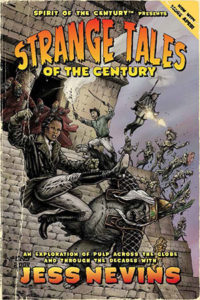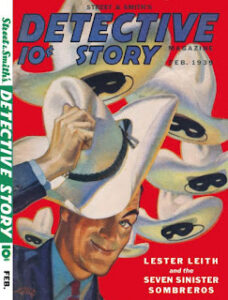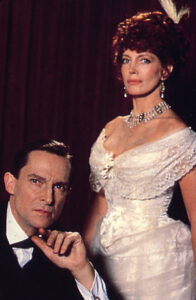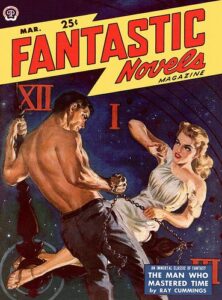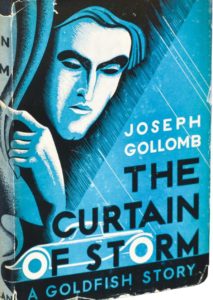Jess Nevins explores deep into the forgotten histories of the fantastic and brings those tales back to us.
Sometimes the ideas suggested by pulp fiction can be more interesting than the actual stories. What often excites me about pulp fiction as a genre is the promise it offers of strange worlds, evocative situations, unusual characters, and intense action. Yet this promise is not always realized. Many pulp authors created amazing stories, but even the best writers sometimes came up with insane ideas that they did not have the time or ability to fully develop. Take McCulley’s Crimson Clown as an example of one very strange hero who could and should have engaged in the most freakish escapades, but instead was used to tell relatively pedestrian crime adventure stories. It is Pulp’s promise of weird and beautiful wonder that motivates writers like pulp historian and scholar Jess Nevins to examine the culture and history of pulp fiction even when the specific stories do not live up to the strange adventure they suggest. Nevins was responsible for igniting my interest in pulp fiction with his astonishingly complete Encyclopedia of Pulp Heroes and if you’re into this genre you have likely heard of him.
Over the last decade Jess Nevins has applied his skills as an archivist, researcher, and very prolific writer to bring us variety of texts, both digital and print, that explore the culture, wonder, and history of fantastic fiction. Pulp readers have been blessed in recent times with a growing number of new stories written in the traditional pulp style and the founding of valiant small presses that offer reprints of pulp fiction from the golden age. While the fiction itself becomes more accessible it has always been difficult to find resources that discuss the history of pulp characters, pulp fiction writers, and the culture in which those writers did their work. Nevins has joined the ranks of Robert Sampson, and E. S. Turner as writers who write about the history of pulp fiction with an intriguing combination of passion and scholarly rigor.
In 2013 Nevins added another important resource for those interested in learning more about pulp fiction, and he’s done so in an unusual way. Strange Tales of the Century (ISBN: 978-1-61317-064-9) from Evil Hat Productions is a text that explains the concepts, characters, and ideas from pulp fiction to role-playing gamers to assist them in building Pulp influenced RPG campaigns.While this work is intended for the niche RPG market (it won the 2014 Silver Ennie Award Winner for Best Role Playing Game Related Product) it is also an enjoyable and fascinating piece of Pulp scholarship for readers interested in fantastic fiction who may never take part in a roleplaying game. It is a fascinating, approachable, fun, and surprisingly in-depth introduction to the strange and adventurous world of pulp fiction.
Strange Tales of the Century is not a gaming guide per se, but rather an expansion that serves as an almanac and resource of characters, concepts, campaign hooks, and other information for anyone desiring to use Pulp in a roleplaying game or just wants to learn more about the history of pulp fiction. The book offers a comprehensive encyclopedia of the major character categories and provides examples from fiction from around the world. For instance it defines the Great Detectives like Nick Carter, Sexton Blake, and, of course, Sherlock and discusses hardboiled Bellem P.I.’s like Dan Turner or Sam Spade. If you want to learn about Jungle Lords or Planetary Romance Heroes or Gun Molls or Spinster Detectives or a whole host of other character types and read about the particular heroes or villains that created for pulp stories this is the resource for you.
Additionally Nevins provides the historical context in countries all over the world during the major eras of pulp fiction that will not only allow gamers to make their campaigns more authentic, but will also give general readers an insight to the political and cultural events that influenced the way Pulp characters developed. And the information is truly global. Nevins discusses pulp fiction and provides examples from South East Asia, the Middle East, Russia, and many other countries besides that of Europe and North America.
He also offers a new characters and situations, woven into a Pulp World involving an organization of pulp heroes called the Century Club constructed specifically for Evil Hat Productions. This is how he uses the historical research cultural analysis to revel in the wild possibilities and implicit wonder that we can only get from pulp fiction. We all know about Sherlock Holmes and James Bond, but by examining fantastic fiction worldwide Nevins shows us that every knew idea, character, or story carries with it imagined new universes and unknown events that fascinate, horrify, and inspire in ways we’ve never experienced. This is the central conceit of Strange Stories of the Century. This is a truly useful, incredibly well researched and amazingly comprehensive resource for gamers, source of inspiration for writers and other creators, and a fascinating and enjoyable read for those interested in pulp fiction.
Nevins’ work is alive with the excitement and wonder of what pulp fiction could be and often, but not always, was. We have to admit that the actual prose or breadth of vision of many pulp stories do not reach the heights to which they aspire. This is not to disparage the skills or talents of pulp writers. We know that Lovecraft’s vision stretched human imagination, and Robert E. Howard’s work had a gritty majesty, but there were many more authors who did not have that kind of power. All too often the deadline pressure that was such a feature of the golden age of pulp fiction forced creators to hack away and submit whatever they could, without polish or expansion. This of course often added to the raw, visceral power of the writing, but sometimes we wonder what could have been had the authors had more ability to develop their ideas.
Pulp is an expression of the fantastic and amazing, and Nevins’ love of the genre reflects that sense of wonder. His work illustrates that often the best aspect of pulp fiction is that it cracks open a universe of astonishing possibilities. The very discussion of Pulp, its culture and history, its cavalcade of amazing characters, can be just as thrilling and fascinating as many of the stories themselves.
Citations and related works for your edification and amusement:
Nevins, J. (2005). The encyclopedia of fantastic victoriana (1st edition). Austin, Tex: Monkeybrain press
Sampson, R. (1983). Yesterday’s Faces: A study of series characters in the early pulp magazines Volume 1 Glory Figures (1st edition). Bowling Green, Ohio: Popular Press 1.
